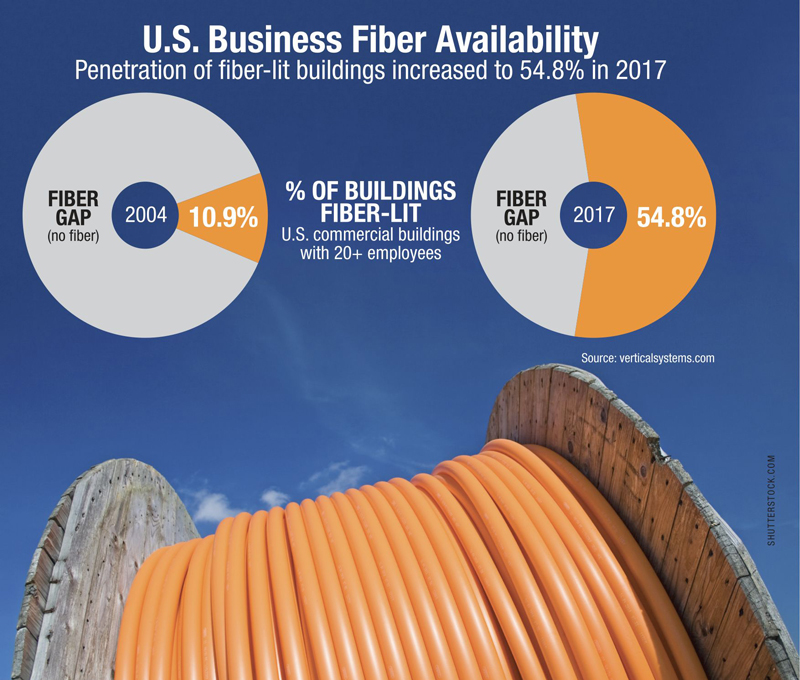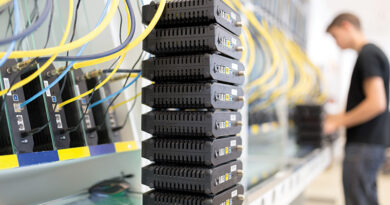High-Fiber Diets for Business Customers
By Robert Kuse and David Ririe
Fiber is an important part of every service provider network. It is used pervasively in the service provider backbone network. It is also an important and rapidly growing part of the service provider access network. Fiber is a flexible transport medium that is the beneficiary of near constant technology upgrades. In less than two decades the carrying capacity of a single pair of fibers has increased from just over 100 Mbps to several terabits per second. These increases in fiber capacity have also brought exponential reductions in the cost of fiber transport. Today fiber transport technologies aggressively compete with traditional access technologies for mindshare in the decision-making process of access network technology decision makers.
There is a lot of buzz today about fiber deeper strategies among service providers. These all involve methods to build access network fiber both deeper and denser in the access network. Among cable providers there are a growing number of active deployments of distributed access architectures (DAA). Distributed access architectures come in several forms but the most common are remote PHY (R-PHY) and remote MAC-PHY. In both cases the coax RF network has been reengineered and uses digital fiber transport to deliver voice, video and data from the service provider core to a remote field node in the access network where it is converted to and from RF in modules called remote PHY devices (RPDs). The R-PHY nodes and their RPDs can be located deep in the access network and connect access fiber from the service provider core to the service provider HFC coax network.
Cable service providers have used hybrid fiber/coax (HFC) access networks for years to serve residential and commercial customers. The introduction of distributed access architectures represents a new tool for service providers to extend the fiber portion of their HFC fiber networks deeper into the access network and closer to their customers. In addition to bringing fiber deeper into the network the new R-PHY fiber nodes also allow service providers to configure smaller service groups. The use of fiber deep distributed access architectures allows service providers to reduce service groups sizes from 300-800 homes passed per service group to 50-250 homes passed per service group based on how the new deep fiber nodes are deployed and configured.
So how deep is a deep fiber network and if fiber access technology is so cost competitive why not fiber all the way to the customer premise? Well the answer to the first is that fiber deep deployments typically bring fiber to within 1,000 feet of the end of the line with many of the homes in the fiber node area passed by fiber. A typical remote PHY build will typically extend fiber to pass nearly 50% of the homes in a service area. So why not fiber all the way? As inexpensive as fiber has become the real costs of FTTH builds are not in the electronics or the fiber. The single greatest cost component of an FTTH build is the cost of construction: the cost to bury or hang the fiber in the access network, and then to replace or extend the fiber from the right-of-way to the customer premise or building. Fiber deeper build strategies allow service providers to incrementally build fiber deeper and improve network performance without incurring the full cost of an FTTH build today. Over time fiber builds will continue to get closer and closer to the customer premise.
So, when does it make sense to build fiber directly to a customer today? In our network we recently encountered situations where the trigger to build FTTH now might be to serve commercial customers. The short history on this is that we encountered several HFC nodes that kept coming up on our network congestion reports. We planned and executed node splits on them and they would appear on our congestion reports again in as little as six months. In some cases, we were on our third node split in less than two years. When we investigated these nodes, we found that upstream bandwidth growth in these nodes was growing dramatically faster than a typical HFC node. When we looked closer at these nodes we found that they were typically commercially focused nodes with over 80% of the passings commercial. These nodes were typically smaller than our residential nodes owing to the fact they had already been split and they were still getting congested. The short summary is that these dense commercial nodes make up less than 10% of our HFC network and grow more than four times faster than a typical HFC node.
It appeared to us that node splits were only treating the symptoms of congestion in these service areas. Node splits were only buying us time, and not much at that. The problem required a stronger solution. Our fiber deeper strategy seemed like a strong candidate. However, we also found that bandwidth utilization within the node was not always balanced. In many cases a small number of users consumed well over half the upstream bandwidth of the node. So immediately after a node split the high bandwidth users were still in the same service group and another node split would be required in short order.
The dilemma of what to do was answered by the very problem we were trying to solve. When we look closely at the network fiber maps for dense commercial HFC nodes we find that they are also very densely penetrated access fiber nodes. Fiber has been built in the nodes for commercial optical Internet services, Ethernet private line services, virtual private LAN services as well as wholesale fiber services. The amount of fiber in these nodes is typically 50% or more of the total plant miles.
The amount of available fiber in these nodes created a situation where the economics of building FTTH made sense now. The cost to build these nodes as FTTH nodes is in most cases less expensive than our average cost to build a remote PHY network owing to how much fiber already exists. We made the decision to build PON in these congested dense commercial HFC nodes as a means of getting ahead of the large bandwidth growth we see.
We began building these new commercial PON nodes late last year. Our commercial sales team started contacting our impacted high bandwidth customers to offer them access to our new all fiber PON services. Initial customer response has been very positive as these PON nodes come online.
Business customers have historically led the way in the deployment of fiber-based access services. Business customers have the demand and the means to pay for the higher bandwidth services available with fiber. In 2017 the percentage of fiber lit commercial buildings in the U.S. exceeded 54% compared to 11% in 2004. This represents tremendous growth in fiber-based commercial services.
These new PON builds provide our commercial customers access to symmetric gigabit speeds with no premium for fiber. This project has been a great example of how far the economics for all fiber builds have come in a few short years. It also illustrates how high-fiber diets are becoming an important part of our commercial access networks.
 Robert Kuse
Robert Kuse
Sr. Director, Access Engineering
Cox Communications, Inc.
Robert leads the Cox access engineering team that manages the technical deployments for Cox FTTH builds for both residential and commercial customers. Robert previously led the Cox commercial services engineering that built a national Cox Business services backbone and metro access network. He started his career at BellSouth and later AT&T. He was part of the product management team that launched DSL services as well as the initial fiber-to-the-cell site builds. He is a former board member and treasurer of the Metro Ethernet Forum.
 David Ririe
David Ririe
Sr. Director, Access Engineering
Cox Communications, Inc.
david.ririe@cox.com
David Ririe serves as a Senior Director in the Access Engineering group for Cox Communications in Atlanta, GA. He has worked in various engineering roles for Cox Communications starting as a Network Engineer in the Omaha, NE market 14 years ago. He has lead the team through a number of transitions and upgrades on both the DOCSIS and PON technology platforms in that time. He began his telecom career in the U.S. Air Force working on various communications and data networking platforms in the air and on the ground.
Editorial credit: Shutterstock.com




